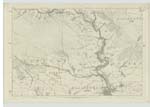OS1/25/42/12
| List of names as written | Various modes of spelling | Authorities for spelling | Situation | Description remarks |
|---|---|---|---|---|
| Supposed Site of the BATTLE OF MONS GRAMPIUS (Continued) | 052 | [continued from page 11] Craig Roman; where as we are credibly informed, several Roman Urns and Roman Spurs were dug up, about 40 or 50 years ago by the proprietor of the ground. The circumstance of Roman Spurs being found there, gives the more probability to our conjecture; because the wings of the Roman Army consisted of the 3000 cavalry who, as Tacitus expresses it, were widely extended on the wings, in order to prevent the Romans from being attacked in flank. - The grounds here would afford full scope for both armies to extend their lines in the manner described by Tacitus; & it is manifest from his description, that the spaces of ground they then occupied and over which they must have passed through the different stages of the Engagement, were in all probability, very considerable - After the Batavian and Tungrian cohorts had begun the Caledonians would fall back towards their entrenchments above the Heer Cairns. It is possible, therefore, that these cairns may be the very spot, where, as Tacitus observes, when Agricola, by a masterly manouvre, turned the strategem of the Caledonians against themselves, and brought on the general rout. Then commenced that dreadful carnage of which the words of Tacitus are so wonderfully descriptive & of which the Heer Cairns may at this day be an affecting Memorial. - The Caledonians, in their retreat northwards over The Guard Drums, seem to have faced about on the summit of each Drum & there to have made a resolute & bloody stand against their pursuers. This appears presumable from the number & position of the tumuli on each of these Drums, and it brings to the mind of the spectator that strong expression of Tacitus, in which he pays an indirect compliment to the vanquished. It likewise appears from the disposition of the tumuli along the neighboring hills, that the flight of the Caledonians previous to their general dispersion was principally by two different routs; the one N.W. [North West] towards the woods of Strathardueil, & the other N.E. [North East] towards those of Maus, where there is also a number of Cairns, seemingly coeval with the others." Old Stat Acct [Statistical Account] for Clunie Ph [Parish] Vol [Volume] 9.259-264. "There is perhaps no single point in the early history of our country which has given rise to so much ingenious speculation among antiquaries as the question regarding the precise locality of the final and decisive battle between the Roman invaders & our Celtic forefathers, generally called the battle of Mons Grampius. What a deal of laborius research of subtle and refined argumentation, of critical acumen - of ponderous and erudite disquisition, have been wasted on this knotty & impracticable subject. For our own part, we have always viewed the question as one which never can be brought to any certain or satisfactory solution. History affords scarcely a glimmer of light to guide us in the enquiry, which must therefore, be pursued by groping, as it were, for evidence among the numerous vestiges of Roman Military Works, & traces of foughten fields which are to be found scattered over the whole face of the country, and when we consider the numerous conflicts which took place before the invaders succeeded in over-running the land & the constant struggle by which the conquered territory was for a time maintained, it must be obvious that the locality of any one particular battle can never be fixed with anything like certainty, but must rest entirely upon a mere preponderance of probabilities & conjectures. If that be the case, you will be apt to exclaim, why take up a subject so unprofitable? Why renew a discussion so unsatisfactory & fruitless? We answer first, because the subject (as Falstaff says) "lay in our way, and we found it"; and secondly because we hope to be able to make out a pretty strong case in favor of the Stormont, as the probable site of the combat in question. - Of course, reader, you have conned your Tacitus in your school-boy days, and doubtless dwelt with peculiar interest on that great historian's brilliant account of the campaigns of his father-in-law in Caledonia; It [continued on page 13] |
Continued entries/extra info
[page] 12[In lefthand margin:]
"Craig Roman"
on 52-14 Blairgowrie Ph. [Parish]
[Note in pencil written sideways to description:]
Here
position of the army
Transcribers who have contributed to this page.
Alison James- Moderator, Brenda Pollock
Location information for this page.
Linked mapsheets.




